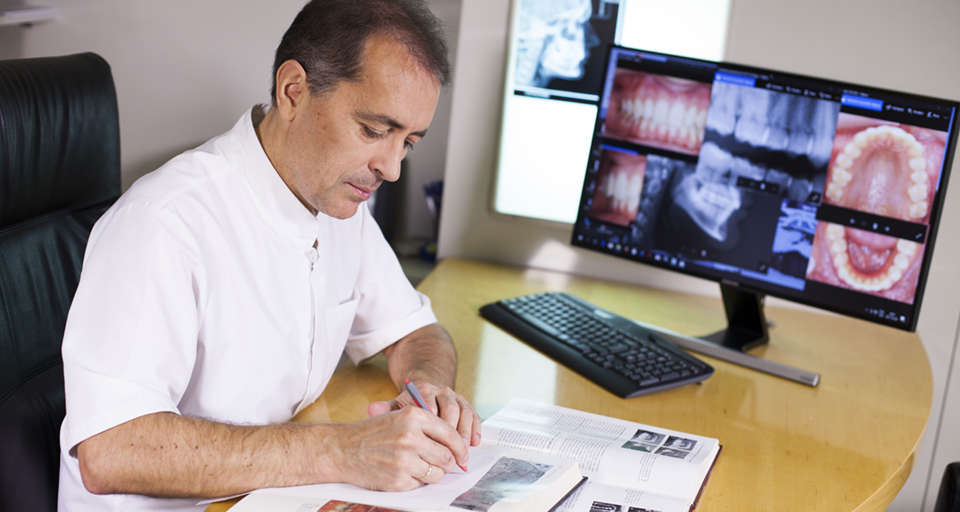Rating dental arch relationships and palatal morphology with the EUROCRAN index on three different formats of dental casts in children with unilateral cleft lip and palate.
Written by admin on January 10, 2016
Clin Oral Investig. 2016 Jun;20(5):943-50. doi: 10.1007/s00784-015-1595-0. Epub
2015 Oct 13.
Sabelis AJ(1), Kuijpers MA(1), Nada RM(1)(2), Chiu YT(3), Bronkhorst EM(4),
Kuijpers-Jagtman AM(5), Fudalej PS(6)(7)(8).
Author information:
(1)Department of Orthodontics and Craniofacial Biology, Radboud University
Medical Center, Philips van Leydenlaan 25, NL 6525 EX, Nijmegen, The
Netherlands.
(2)Department of Developmental and Preventive Sciences, Faculty of Dentistry,
Kuwait University, Kuwait City, State of Kuwait.
(3)Department of Dentistry and Craniofacial Center, Chang Gung Memorial
Hospital, Taipei, Taiwan.
(4)Department of Cariology and Preventive Dentistry, Radboud University Medical
Center, Nijmegen, The Netherlands.
(5)Department of Orthodontics and Craniofacial Biology, Radboud University
Medical Center, Philips van Leydenlaan 25, NL 6525 EX, Nijmegen, The
Netherlands. annemarie.kuijpers-jagtman@radboudumc.nl.
(6)Department of Orthodontics and Craniofacial Biology, Radboud University
Medical Center, Philips van Leydenlaan 25, NL 6525 EX, Nijmegen, The
Netherlands. orthodontics@dent.umcn.nl.
(7)Department of Orthodontics and Dentofacial Orthopedics, University of Bern,
Bern, Switzerland. orthodontics@dent.umcn.nl.
(8)Department of Orthodontics, Palacky University Olomouc, Olomouc, Czech
Republic. orthodontics@dent.umcn.nl.
BACKGROUND: The EUROCRAN index has been used in inter-center studies to assess
dental arch relationship (DAR) and palatal morphology (PM) in children with
unilateral cleft lip and palate (UCLP). For this type of inter-center research,
a scoring method that could be performed over the internet would be the most
effective. Therefore, the aim of this study was to investigate the reliability
of application of the EUROCRAN index on 3D digital models or photographs of
plaster models instead of using plaster models.
METHODS: The EUROCRAN reference models were presented in three formats: plaster
models, 2D photographs of plaster models, and 3D digital models. Plaster models
of children with UCLP (n = 45) were rated. Of each case, all three formats were
rated by six calibrated observers in random order. The strength of agreement of
the ratings was assessed with kappa statistics. Concordance among observers was
evaluated with the intra-class correlation coefficient (ICC).
RESULTS: The ICC showed a good inter-observer agreement for the DAR and poor
inter-observer agreement for the PM. Intra-observer agreement for the DAR was
moderate to very good, yet for the PM poor to moderate. Comparison between the
three formats per observer for the DAR was good or very good and for the PM
moderate to poor.
CONCLUSIONS: The overall results show that the EUROCRAN index is an acceptable
and reliable scoring method for the DAR on plaster models, 2D photographs of
plaster models, and 3D digital models. However, due to the small range of
deviations in palatal morphology between the cases in our study, the PM
component of the index was difficult to assess.
CLINICAL RELEVANCE: In clinical audits and inter-center studies, plaster models
can be substituted by 2D photographs of plaster casts or 3D digital models when
grading treatment outcome with the EUROCRAN index.
DOI: 10.1007/s00784-015-1595-0
PMCID: PMC4873539
PMID: 26462656 [Indexed for MEDLINE]




